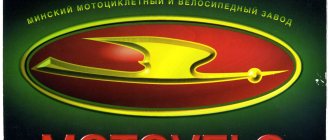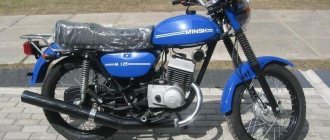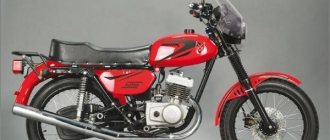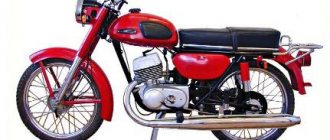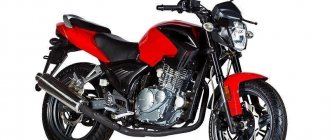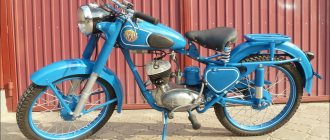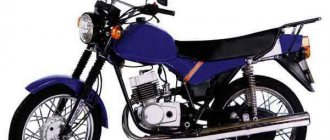"Minsk" MMVZ-3.112
- a light road two-seater motorcycle from the Minsk motorcycle family produced by the Minsk Motorcycle and Bicycle Plant (BSSR, Republic of Belarus, Minsk, modern name - Motovelo OJSC). Produced from 1980 to 1995 (along with modifications). The predecessor is the Minsk model MMVZ-3.115, the successor is the Minsk MMVZ-3.113.
Marking means:
- MMVZ - manufacturing plant;
- 3 - motorcycle class (up to 125 cm³);
- 1 — type of motorcycle (road);
- 12 - serial model number.
Basic model device
The MMVZ-3.112 motorcycle model is a further development of the previous Minsk model MMVZ-3.115. The main differences are a new, more comfortable, wide and long saddle (it hinges to the right along the way and can be removed from the frame), brake drums of both wheels increased to 150 mm in diameter, the use of damping elements in the driven sprocket assembly, and the installation of a pendulum fork on silent blocks, the presence of a new yoke on the frame, making it easier to place the motorcycle on the center stand. The rear brake support plate transmits reaction force to the frame not through stops, but through a reaction rod attached to the pendulum. The brake pedal is mounted on a separate bracket rather than on the footrest tube. The diameter of the wheel hubs and the spokes themselves have also been increased. The spokes became shorter, which overall made the wheel more rigid. The comfort of the motorcycle has been slightly improved.
Engine
The engine is single-cylinder, air-cooled and dual-channel return blown. Aluminum alloy cylinder head. The cast iron cylinder liner is pressed into aluminum fins. Advanced finning of the cylinder and head ensures effective cooling in difficult road and weather conditions. The engine runs on a mixture of low-octane gasoline A-76 with almost any type of motor oil. The engine on the MMVZ-3.112 model produced in 1982 developed a power of 12 hp. at 6,300 rpm, in 1986 a new modification appeared - MMVZ-3.112.11 with a derated engine so that the motorcycle could be used not only on highways.
Transmission
The gearbox is four-speed. The gear shift mechanism is foot-operated. Multi-disc clutch in oil bath. The drive to the rear wheel is by chain, with the main drive protected by stamped casings and rubber chain covers.
Chassis
The frame is tubular, closed type. Telescopic front fork with hydraulic shock absorbers, pendulum type rear suspension with hydraulic shock absorbers.
Electrical equipment
Electronic contactless, batteryless ignition system. The headlight and tail light of the MMVZ-3.112 model are identical to those used on the previous model, the electrical equipment of the MMVZ-3.112 is 6-volt (G427 generator, B300B ignition coil). In 1984, model 3.112.1 began to be equipped with 12-volt electrical equipment (generator 43.3701, coil 2102.3705, lighting devices that meet the requirements of European standards), which distinguishes them favorably from the MMVZ-3.112 model. In 1995, the plant announced a new 14-volt flywheel-type alternating current generator with a power of 90 watts.
Minsk
Now it’s impossible to believe it, but the history of motorcycles from the Minsk plant began in a dilapidated haberdashery factory in the capital of Belarus. In the autumn month of 1945, large-scale efforts began there to restore a few industrial buildings and auxiliary premises. The work was carried out in emergency mode, the country was in dire need of technical means of various profiles, and serious expectations were placed on the future plant. As soon as the production premises were put under the roof, the plant received the first deliveries of equipment and accompanying technical documentation from the engineering plant in the city of Zopau. In the confiscated drawings one could see the future Minsk motorcycle, the development history of which continues to this day. Subsequently, the plant, raised from the ruins, became a leading manufacturer of equipment, and its Minsk motorcycle, the history of the model of which is detailed in this article, acquired the meaningful epithet “Legendary.” The summer of '46 showed that there would be a plant! The first two workshops produced spare parts for the first bicycle of the Soviet country. Within a year and a half, the machine-building enterprise reached a production level of almost seven thousand units! In subsequent years, new brands of bicycle equipment for teenagers were developed - “Lastochka” and “Eaglet”. Since 1951, the plant in Belarus has been heading towards motorcycle technology, and then the Minsk motorcycle was born, the history of its models deserves special mention.
Motorcycle "MMVZ-3.112
1980 opened a new decade and marked the beginning of the production of a new model of motorcycle equipment - the MMVZ-3.112 motorcycle. The Minsk Plant has supplemented the MMVZ model range of two-wheeled vehicles with another development, which replaced the Minsk MMVZ-3.115 model. The new technology has become truly universal; it moved with equal success both on the highway and in other areas.
How did the MMVZ-3.112 model differ from the previous ones?
The engine of the MMVZ-3.112 model accelerated at 95 km/h and had a power of 12 horsepower. Drivers who love comfort will immediately notice the comfortable seat with increased width. The spokes in the wheels became wider and more substantial, while their length decreased, due to which the wheels acquired additional rigidity. There was one cylinder of 123 cubic centimeters providing it with excellent running properties. The cylinder has aluminum fins that hide the built-in inner liner. This design move contributes to the most efficient cooling of the engine, regardless of the ambient temperature. The MMVZ-3.112 model was produced at the Minsk plant until 1984. Subsequently, the motorcycle was modernized by factory designers, and the result of their work was a new production model - MMVZ-3.112.1.
Motorcycle "MMVZ-3.115
MMVZ-3.115 became the flagship product of the Minsk plant in 1976. The predecessor of the middle class motorcycle MMVZ-3.115 was the factory development of the MMVZ-3.111 model. The MMVZ-3.115 model received the short name “Minsk”; its weight was 112 kg. The motorcycle was equipped with a K-62S carburetor. It operated on a mixture of oil and gasoline, fuel consumption was 4 liters per 100 km. Tank 12 liters. Very soon this motorcycle model earned a reputation as a technique. 1980 marked the end of the production of the MMVZ-3.115 motorcycle model and gave rise to a new technology - the MMVZ-3.112 motorcycle.
Motorcycle "MMVZ-3.111
In 1973, the Minsk Plant presented its new development - the MMVZ-3.111 model. The light motorcycle accelerated to 90 kilometers in a short time. Despite the fact that the equipment was in high demand in the Soviet country, its production was discontinued after 3 years. This was due to the fact that the MMVZ-3.111 model underwent a number of changes, which gave rise to a new improved version - MMVZ-3.115.
Minsk M-106
"Minsk M-106" MMVZ embodied the spirit of freedom that was in the air of the 60s. Another Minsk motorcycle, the history of the models continued in 1971. It was significantly different from its predecessor, the Minsk M-105 model, despite the fact that, in essence, it was its direct modification. The 123 cubic centimeter engine had a power of 9 horsepower at 5.5 thousand rpm. The fuel tank of the motorcycle was designed for an increased volume of the combustible mixture - 12 liters. The model, released by the plant in 1971, reached a maximum speed of 85 km/h.
The company's designers paid special attention to technical design and comfort. In addition to the fact that the new motorcycle acquired an attractive appearance, it received a significant advantage for those times - a trunk, which Soviet buyers loved so much that it was decided to introduce this innovation as standard equipment for this and all subsequent models.
And again, the Minsk history of motorcycles was enriched with yet another development. In 1973, the “Minsk M-106” was replaced by the creation of the factory design engineers - the M-106 motorcycle.
Minsk M-105
In 1967, the Minsk Motorcycle and Bicycle Plant pleased all lovers of two-wheeled vehicles with the new M-105 motorcycle, which replaced the Minsk M-104. It embodied those improvements and modifications; they were made on the basis of an already produced motorcycle. The designers deliberately made it so that even a person far from technical could handle it. The speedometer now has bright backlighting, and a brake light has also been installed. A pendulum appeared on the rear wheel. Compact dimensions, high reliability, excellent maneuverability, good cross-country ability - very soon the motorcycle became a scarce commodity. Residents of the rural outback were pleased with the fact that spare parts for it were not difficult to find, and city residents valued the motorcycle for its nimbleness.
After 4 years, the production of the Minsk M-105 motorcycles was discontinued due to the development of a new model, the M-106.
Minsk M-104
Closer to the mid-60s, the Minsk Motorcycle and Bicycle Plant introduced the new “Minsk M-104”. With its appearance, it completed the production of the previous model “M-103”. Its weight was 90 kilograms, it could be loaded without exceeding 150 kg. The engine was 123 cc. had a power of 5.5 hp, it allowed a maximum speed of 75 km/h. The heating engine was cooled with air; for this purpose, purge from two channels was provided. "Minsk M-104" acquired a new effective muffler. The lightweight motorcycle had an improved appearance, which was enhanced by individual elements: next to the carburetor and in the seat part - trim panels, on top - a two-seater cushion seat.
For three years, from 1964 to 1967, it was successfully produced, then it was replaced by the Minsk M-105.
Minsk M-103
In 1962, the 250 cc Minsk M-101 motorcycle gave way to the new brainchild of Minsk designers - the M103 motorcycle. The Minsk Motorcycle Plant worked on the M103 model until 1964, when the technical thought of the factory specialists brought out the Minsk M104 motorcycle.
Minsk M-101
The beginning of the 60s was marked by a new development by Belarusian designers. This Minsk motorcycle history photo is very interesting. MMVZ started producing the Minsk M-101 motorcycle instead of the previously produced M1M model. The innovation of the development was expressed in the fact that the engine of the released model of equipment consisted of two 250 cc cylinders. cm. His weight was 130 kilograms. The Minsk “M-101” motorcycle series did not receive a long-term perspective; the factory team limited itself to a small number of these models.
It was replaced by the Minsk M-101 model and its successor, the M-103 model, whose engine was designed for 125 cc.
Motorcycle M1M
In 1956, the plant in Minsk produced a new M1M road truck. With its release, it completed the serial production of the technical model M1A, called “Moscow”. Thus, the history of motorcycle Minsk has been enriched with another rarity. The weight of the new technical development was 80 kilograms, which was especially liked by users of country dirt roads, who were no longer afraid of dirt and mud. In 1961, this model was replaced by the Minsk M101 motorcycle.
Motorcycle M1A "Moscow"
From which source the Minsk motorcycle originates, the history of the M1A “Moscow” model shows most clearly. The M1A “Moscow” model motorcycle has become a real rarity of the plant. The history of motorcycles from the Belarusian manufacturer dates back to this single-seater model of 1951. The prototype of this technology was a motorcycle from Germany “DKW RT 125” - its drawings formed the basis of the first Minsk motorcycle. Not only the history of Minsk motorcycles began with a copy of German technology. The famous motorcycle “Kovrovets” K-125, the production of which was established in the Vladimir region, also resembled its German counterpart, like two peas in a pod. For only one five-year period, motorcycles of the M1A “Moscow” model were produced at the Minsk plant. After this, in 1956, the production of a new, well-proven model M1M was launched. Simplicity of control, high reliability, reliability and cross-country ability - these are the distinctive features of the first in-house development of the plant workers.
Like the Minsk motorcycle itself, the history of the development of the manufacturing enterprise also dates back decades. But the tradition continues in our time. But the traditions and history of the Minsk Motor Plant continue in our time. The new model MMVZ-3.113.5, called “LEADER”, was introduced to the market in 2003. Designers from Belarus paid special attention to the appearance of the motorcycle - it turned out to be truly presentable and modern. At the same time, technical improvements to this model began, which acquired such proportions that the modernized version received its own serial number MMVZ-3.114. The new motorcycle is equipped with a five-speed gearbox. This equipment is produced for export.
Today, the plant produces a cargo modification of motorcycle equipment - the S-3.901 cargo motorcycle. The next generation models have also been launched and are equipped with 200 cc four-stroke engines. see. Now the Minsk Plant has developed partnerships with foreign manufacturers, which provide for cooperation in the development of new generations of modern ones.
This is where the history of motorcycles from the Minsk plant ends. As you learned, she went through a difficult path to perfection. But nowadays it produces some pretty good motorcycles.
Modifications of MMVZ-3.112
- MMVZ-3.112.1
(1984-1986) further modernization of MMVZ-3.112. Number of gears - 4, engine power - 12 hp. at 6,950 rpm, maximum torque 1.2 kgf•m at 6,800 rpm, maximum speed 95 km/h - MMVZ-3.112.11
(since 1986) - derated modification ("rural" version of the MMVZ-3.112.1 motorcycle), engine power - 10 hp. In order to increase cross-country ability, the rural modification was equipped with a final drive with an increased gear ratio, the front wheel mudguard was raised, the muffler shape was changed, and the ground clearance under the engine was increased, replacing the central stand with a side support. The steering wheel was equipped with a jumper to increase rigidity. The muffler of the “rural” version is collapsible. Exported to Bulgaria, Hungary, Vietnam, Cuba, Laos, Mongolia, Romania, Serbia, Syria, Czechoslovakia - MMVZ-3.112.12
(since 1991) - MMVZ-3.112.13
- MMVZ-3.112.14 “Pioneer”
- MMVZ-3.112.15 “Sputnik”
- new fork 3.1122 with aluminum sliding pipes.
